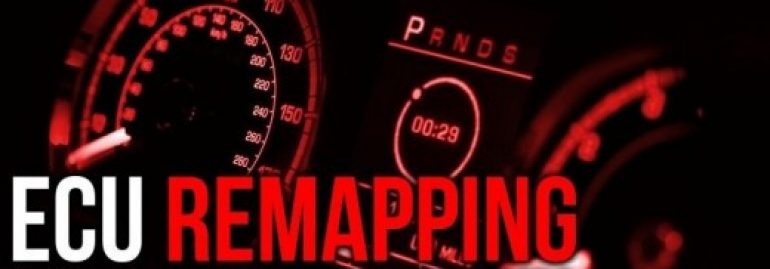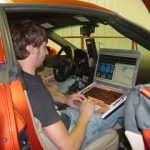(Part 2 of Car Tuning Talks About Technicalities. While Part 1 talks about basics you need to know before reading this article.)
Back in the day, timing the ignition spark was done by a car’s mechanical distributor. In those far off days the greater the Revs Per Minute, the more the timing would advance.
Are you old enough to recall how mechanical and clunky it was? But it did the job reasonably well, didn’t it?
Well, when the electronic ignition system came along it was a relief. Now we had been given much better control over our car’s fuel delivery and the timing of those sparks.
A full map of variables was entered into the program for ignition and the timing that was preset would come from a table. Engine speed, air temperature, engine load and control over the turbo or wastegate control and rate of fuel delivery meant that precise management of the engine ignition timing was possible and we could achieve maximum power output through the whole rev range.
What is ECU remapping?
In the early 1980s car technology suddenly changed in a dramatic fashion. What drove this adjustment was computer technology and its implementation. Electronic control units (ECUs) were built into vehicles to improve efficiency and performance.
In those early days ECUs only controlled a few processes, but after leaps and advances in both computer and electronic technology ECUs now control a huge number of a car’s mechanical and electronic processes.
Nowadays the signals from sensors placed on both the engine and the chassis transmit vital information to the ECU and as a result real time adjustments are made in real time. Boost pressure, engine speed, fuel pressure, lambda, pedal position and cam timing are examples of the ECU measured parameters and those the ECU can control.
Like our home PC has software drivers that control the computer’s hardware (printer, CD drive, speakers, for example) ECUs also have software or programs loaded onto them that control an engine’s hardware components. It is this program that is referred to as a map. A map file that is extracted from one ECU will in reality contain many different maps. There may be a Boost Map, a Fuel Pressure Map, an Injection Quantity Map, one for the lambda and many more.
These individual maps can then be modified and reloaded to the ECU by extracting the map data from it in the first place. When the maps are recalibrated correctly, it can improve the drivability, the performance, and the efficiency of an engine. The process is named Remapping.
It is a rare care these days where the performance with factory settings is not a long way away from that model’s engine’s true potential. Indeed manufacturers have been accused of wilfully detuning their cars electronically. However, there are significant reasons for vehicles being detuned.
It is a rare vehicle today that is not manufactured for sale globally. This means that each model has to be able to deal with a myriad of different environments. It must also be able to handle any poor quality fuels that may be available in the world’s less developed countries. It is expected to perform at both low and high altitudes. Cars today are expected to survive with poor or even non-existent servicing and in severely different temperatures.
Vehicles built in Japan have to cope with high air temperature in India, while also performing in Russia’s freezing winters. So, when a car manufacturer produces a vehicle’s map, compromises have to be made. Performance is what tends to suffer so the vehicle is able to perform in different environments.
On top of this there are increasingly stringent rules and regulations about exhaust emissions of new vehicles, and growing political pressure for producing environmentally friendly vehicles.
In those countries where there are few environmental and other issues coupled with good quality fuel and supported by a good servicing regime, it is possible to tune vehicles without compromising on reliability. Indeed, it is possible to tune vehicles to their maximum potential.
There are certain vehicles that offer often incredible boosts in power and torque following a Remap. These are often those that are radically detuned at the factory. Manufacturers now commonly produce one engine, but offer it in many power options.
Take, for example, the Ford Transit 2.2 TDCI. This vehicle is offered in four power guises. This is only possible because of the different maps that are loaded on the ECU at the factory. One engine is a detuned version of another etc.
It is too complex to explain in a few words how maps can be adjusted but for now suffice it to say the internal combustion engine burns fuel and air. The chemical reaction is converted in to kinetic energy. Remapping the ECU alters the proportion of air and fuel that gets into an engine.
On a turbo air quantity can be boosted by the turbo boost pressure being increased. In addition the fuel quantity can be enhanced by adjusting the maps related to fuel injection. If the quantity of fuel is adjusted and air is then injected into the combustion chamber it will alter the torque, power along with the efficiency output.
This is a simplistic explanation because there are numerous other factors that come into play when a combustion engine is tuned.
When should the fuel be injected in the engine cycle? How long should the injection period last and when should the fuel be ignited.
Remapping is all about fine tuning and making sure the balance is right for a particular engine design.
What electronic ignition does is allow car manufacturers to fine tune a car’s economy at the most popular road speeds, for example 30mph, 60mph and 70mph.
These are the speeds at which most cars spend a big proportion of time. What is now possible is for the timing to be advanced when the throttle is wide open. This gives more power. It is also possible to back the timing off when the driver is cruising at a constant speed for improved fuel economy.
Manufacturers create timing maps with an inbuilt margin of error that enables the cars to cope with and adverse conditions like temperature, bad road conditions and minor faults. Some countries have emission targets that vary. These will usually need to be fudged.
The car makers don’t want a reputation for uneconomical cars. Nor do they want drivers breaking down or suffering the inconvenience and expense of premature parts failure. As a result a wide margin of tolerance is built into modern cars.
There are different grades of fuel in different countries as there are various weather conditions, and manufacturers have to take all these into account because they can’t afford to build a model for each country in the world.
So, rather than putting every car through its own assessment and getting a bespoke timing map for each, the car makers adopt the standard philosophy of one map is expected to fit all.
It can’t be denied that manufacturers also use remaps to create different versions of power from the same engine. Consequently there are lower insurance cover ratings and better fuel consumption figures.
The makers also build in to their map equations the possibility that users aren’t as proud of their vehicles as they should be. This leads to cars not being given the regular TLC they deserve for all the work we expect of them. Infrequent servicing is all too common. This causes dirty plugs, clogged air filters, bad leads, blocked injectors and more.
Why remap?
When anyone adds a performance part to an engine he or she should really be considering a remap too.
There are significant benefits to be had. With turbos equipped with electronic controlled fuel injection, the power gains on offer are massive.
There are hidden costs and a few drawbacks. For example be prepared to have a remapped car serviced more frequently. In some cases this involves reducing the interval between services by half.
High quality fuel and perhaps high octane fuel may be needed if this is inherent in the map. And remember the extra work the engine will be doing will lead to components wearing and tearing.
Engines that are tuned to generate more power, mount up the strains and stresses on the vehicle, leading to things like air flow sensor failing.
Rest assured engine weak spots if they exist will reveal themselves a few months after a remap. In general weakness in turbos and clutches show themselves at this time. Other things on turbos that tend to wear out include pistons and bearings. These therefore need extra attention
For people without turbos a remap on its own is rarely enough to get the boost that is sought after. It’s a good idea for those with non turbo cars to think about modifying everything else first. That’s things like pistons, cams, increased compression, air intakes, exhausts, getting the engine balanced and more.
When all these aspects have been attended to then a remap is worth considering in order for the full benefit of all the other work can be enjoyed.
It’s worth knowing that with turbos, remaps often cause the boost to happen from the lower reaches of the rev range and as a result the turbo runs faster and hotter.
If this happens then it’s important to allow the turbo to cool down before shutting the engine off. If this isn’t done the oil degrades and an expensive turbo repair is to be budgeted for. A turbo timer is recommended to help in this situation.
The amount of power chosen is connected to the cost and reliability of running a car. A lot of people choose an off-the-shelf remap for between £200 and £500. These are often better than manufacturer maps because they employ tighter parameters but it’s still a job where one size fits all.
For those people who want large power boosts, have already switched some major components, like the turbo, and have tackled some extensive work on the engine then the best option has to be a custom remap.
Switchable maps are ‘de rigueur’
Times they are a changing and now it’s possible to store a few switchable maps from which to make a selection. There is a valet mode that means boy racers will be stopped in their tracks if the enthusiastic drivers among your garage’s mechanics get a bit fruity on any test run they decide is imperative.
Often there will be an economy option for frugal fuel consumption. Of course there are the power/sport modes which pump out a lot of energy and more often than not call for high octane fuel.
Maps that use the cruise control to make the choice of map are available. Other options include handheld devices that enable a range of maps to be chosen and uploaded. Typically it can take around three minutes to flash a car through the On-Board Diagnostics so instant responses are not to be expected.
The majority of people run an economy map on their daily commute and switch to a high performance map on the weekend. If doing a track day they tend to plump for a race map.
Of course nothing ever is 100 per cent simple and some ECUs are just not reprogrammable.
In these circumstances the option is a piggy back ECU, aka an aftermarket ECU. Piggy backs connect between an existing ECU and the inputs and outputs on the engine sensor.
Each one works a little differently but apply some if not all of these combinations:
- some adjust sensor readings for items like engine speed air temperature, and crank position
- Others do their own calculations to take control of engine management aspects like ignition timing and turbo waste gate control.
- yet more take standard ECU outputs and modify the signals
Tuning boxes, which are relatively new, adjust the readings that go to and fro between the ECU giving extra economy or power.
Often aftermarket ECUs are direct replacements for a car’s ECU. These will take control of all associated functions. They tend to be fast and able to cope with factors like water methanol injections and turbo timers.
Beware those piggyback and aftermarket ECUs that don’t include any knock protection. When this is the case it requires the timing to be set conservatively and for the car to be filled with high octane fuel.
It is still; of the utmost importance for the car to be in the best condition possible because by remapping the tolerances that were built in for cheap fuel, dirty plugs or electrical faults will be removed.
So it’s not the mechanics that hold back a car’s power and performance. It’s the software that runs the engine control unit (ECU).
The ECU is responsible for the computer algorithms than run in the background when a car is being driven. These are rarely optimised for driver to enjoy ultimate performance.
Whatever a driver wants to change – performance, pulling power, fuel economy – the place to look is a little black box that sits under the bonnet. Changing the settings in an ECU is often called ‘chipping’, engine ‘tuning’ or ‘remapping’.
What does chipping and remapping cost?
The sky is the limit when it comes to what people can pay for engine remapping. Although it is possible to have a car chipped by a reputable dealer for as little as £150, the costs rack up if more advanced services and parts are desired.
What model of car is a determining factor in the cost of chip tuning? Diesel engined cars are the cheapest to chip, while the most expensive are the specialist systems that extract increased power from more high performance models.
For about £300 / US$400 it’s possible for a car to be chipped and tested on a rolling road so ECU remapping effect can be monitored. Some engine tuning firms also offer a mobile service.
Home ECU tuning
There is no doubt about it: tuning is a lot of fun, especially when the results show an increase in a car’s performance and efficiency that is veritably amazing.
It can also be very dangerous, if it’s not done correctly. When a petrol engine is run too lean and with too much advance on the timing it can lead to an explosion.
This can be catastrophic in terms of engine damage. If too much fuel is injected into a diesel engine, it can also lead to damage. Piston damage can occur is internal combustion temps increase because of the extra energy created.
Since the beginning of 2001 all petrol cars bought inside Europe have to have On-Board Diagnostic (OBD) systems monitoring their engine emissions. This also applies to every diesel car built since 2003.
OBD equipped vehicles also have an OBD port. This is a communication port that is designed to enable allow diagnostic equipment to investigate and reprogram any ECUs that are fitted to a vehicle. This OBD port’s introduction totally transformed the method in which tuners were able to access map data stored inside an ECU. Example TOAD software can successfully tune any car map.
The most efficient and least intrusive method of tuning is to remap through an OBD port. It enables tuners to produce spectacular results without a bonnet even being opened. With specialist equipment for remapping, it is possible for the ECU data to be extracted via this OBD port. Then when the data has been modified it can be reloaded to the ECU using the same process.
There are many reasons why it is not always possible to remap through this OBD port. For a start the car may not be fitted with an OBD port. Otherwise the port may be faulty or it may have been protected by the manufacturer.
The process that is used in these circumstances is called bench tuning. It is a nick name for removing an ECU from the vehicle and directly connecting the ECU’s internal circuit board on the “work bench”. Once there are other methods for communicating with the ECU.
Background Debug Mode (BDM) is where a direct connection is made to the ECU’s circuit board. It requires a specially engineered jig holding the ECU while the circuitry is connected to the data pins.
Chip Tuning or ‘Chipping’ originally got its name because primitive ECU systems contained chips, otherwise known as EEPROMs. These stored map data. To be able to read this data in these chips, tuners would often de-solder a chip from the board and place it in a reader.
The data could then be modified and reloaded to a chip. Unfortunately, these early chips were often what is known as One Time Programmable (OTP). This meant although new modified map data couldn’t be programmed back on to the same chip.
To get over this hurdle, a tuner would program the modified data into a new chip with and then solder this new chip to the circuit board. A process that became known as chip change.
—
If you haven’t already, please FIRST read Part 1 of this Car Tuning ‘How-To’ Series: Getting Started With Car Tuning: Part 1 – The Basics






